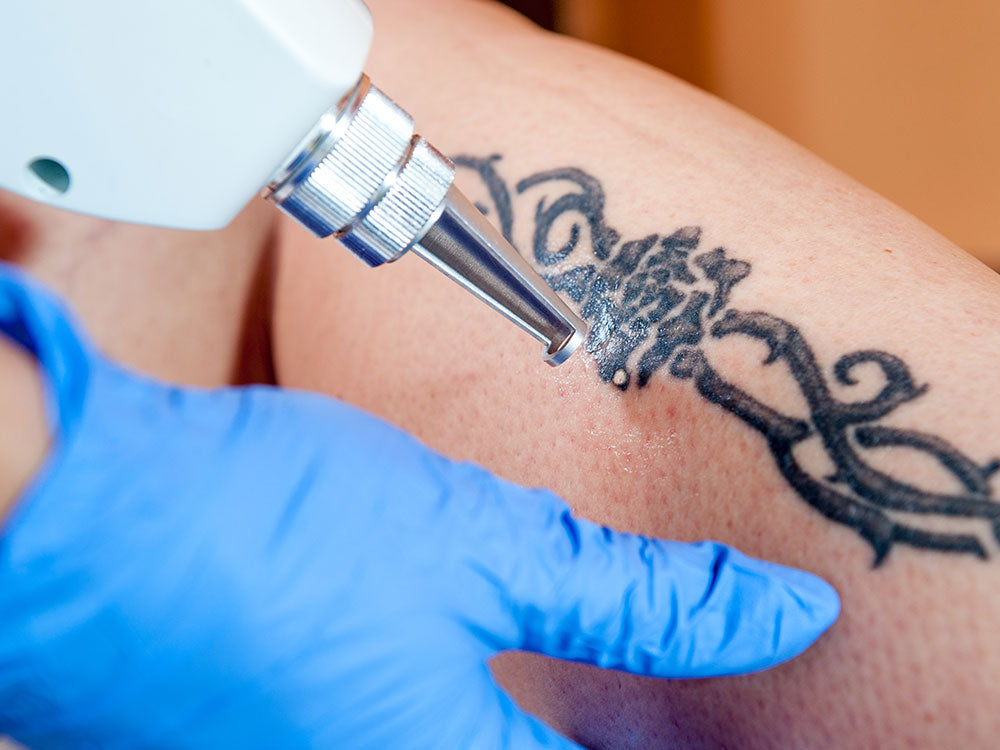Table of Content
Tattoos are one of the fastest-growing fashion trends among the youth. The increasing popularity of tattoos has also led to a rise in the rate of tattoo removals. People get their tattoos removed mostly because they regret permanently marking their bodies. Faded tattoos, tattoos in visible areas, lack of confidence, or a change in interests are also reasons why people get tattoo removals.
Over time, a poorly made tattoo can negatively affect self-confidence and mental well-being. Getting an unwanted tattoo removed provides a sense of freedom and peace of mind.
Luckily, advanced medical research and procedures have made it possible to remove a permanent tattoo. However, depending on your chosen method, it can be time-consuming, expensive, or painful.
In this article, Viking Bags has a list of possible ways you can remove a tattoo.
1. Why Do Tattoos Not Come Off on Their Own?

Tattoos are applied using specialized needles that penetrate the first layer of the skin (epidermis) and insert pigments or ink in the second layer of the skin (dermis). The epidermis quickly sheds old damaged cells and replaces them with new cells through regeneration. However, regeneration is relatively slow in the dermal layer, causing the ink particles to remain trapped there for years. Since new cells are not created quickly enough to replace the insoluble ink, tattoos do not come off naturally.
Secondly, when getting a tattoo, both layers of skin are damaged. The immune system kills bacteria in both layers but is unable to break down the ink particles in the dermal layer. This immune system is unable to phagocytize or disintegrate the pigments results in the tattoo being permanent.
2. Effective Methods for Tattoo Removal

Possible ways you can get your permanent tattoo removed include home remedies, tattoo removal creams, laser therapy, non-invasive procedures, and highly invasive methods. All of these tattoo removal methods work, but do not have the same results. Several factors determine the effectiveness of a tattoo removal method, including
Age of a Tattoo
For example, to remove a fresh tattoo, a simple home-based DIY would not be effective. Similarly, laser treatment would not be ideal if your tattoo has laser-resistant ink.
Color of a Tattoo
Some pigments are more difficult to remove than others, including dark blue, violet, brown, emerald green, and black. Older tattoos or tattoos featuring lighter colors take less time and are easier to remove.
Side Effects of Treatments & Health Complications
Potential side effects or health issues can also limit possible tattoo removal options. People with darker skin, and suffering from skin diseases, allergies, and health conditions cannot use highly invasive or laser treatments.
You are encouraged to do extensive research and get advice from medical professionals.
2.1 DIY Tattoo Removal Home Remedies
When it comes to tattoo removal, it is best to seek professional help. Never try to remove tattoos on your own. However, those who are unable to afford advanced tattoo removal treatments opt for home remedies like salt scrub and lemon juice. Contrary to popular belief, these remedies do not work as they cannot reach the dermal layer where the tattoo ink is grafted. A lack of results can result in frustration, over-exfoliation, skin damage, and infection.
2.2 Non-Invasive Tattoo Removal Methods
Non-invasive methods do not involve breaking the surface of the skin and physically inserting something into the skin layers. For tattoo removal, there are a number of non-invasive methods that are economical, effective, and painless. However, not all non-invasive methods are safe or effective.
Wrecking Balm
Tattoo removal creams and wrecking balms often get more attention than they should. Cheap and easily accessible, these creams include bleaching and skin-lightening agents like Hydroquinone, which is known for its carcinogenic nature. Though it is believed that using these creams will make tattoos easier to remove, none of these claims are backed by any reliable research or evidence. It is best to avoid using wrecking balms to lower the risk of contracting serious skin diseases.
Chemical Skin Peels for Tattoo Removal
Chemical peels, derma peel, or chemexfoliation are acidic solutions applied to the skin to remove older skin cells in the top layers. Normally, chemical peels are used to treat wrinkles, skin discolorations, freckles, and other skin issues. Here are the steps for this procedure:
- Apply skin conditioner for four weeks or as recommended by the dermatologist. The skin conditioner removes most of the upper layers of skin, allowing the acidic solution to reach the deeper layers.
- Once skin conditioning is complete, the dermatologist applies an acidic solution to the skin for up to 10 minutes or more.
- Next, the dermatologist may apply a neutralizing solution.
- Finally, the area of the skin where acidic and neutralizing solutions were applied is cleaned.
Though an effective skin rejuvenation method, dermatologists usually don’t recommend this procedure for tattoo removal as it does not penetrate deep into the dermal layer. A deep chemical peel can remove a small or older tattoo, but it may still not be as effective.
If you are planning a chemical peel tattoo removal, it is recommended that you consult a dermatologist. Unfortunately, many chemical peels are readily accessible online, often resulting in people performing this procedure without proper care and supervision. Over-exfoliation or aggressive use of chemical peels may cause scarring, infections, bleeding, etc.
Laser Tattoo Removal Surgery

Laser surgery is the most effective and painless tattoo removal method. The lasers can completely remove older, smaller, and simple tattoos. However, laser treatment may not completely remove all traces of a fresh tattoo with a complex design. The tattoo will fade considerably, but if you look closely, you will be able to make out the dull outline of the tattoo.
More effective and cheaper than alternate tattoo removal techniques, laser surgery is also a quick removal option that provides desired results in 6 to 10 sessions over the course of 6 to 8 weeks. Today, there are four types of laser techniques used for tattoo removal:
Standard Q-Switched Alexandrite Laser
The Standard Q-Switched Alexandrite Laser is most effective when removing green, blue and black inks. This laser treatment is not suited for removing red tattoos since it emits a wavelength of 755 nm. This laser treatment can cause skin discoloration and is not recommended for people with darker skin.
Q-Switched Ruby
The Q-Switched Ruby is the safest tattoo removal method. It generates short pulses of red light that easily penetrate the skin and become absorbed by the ink. The pigments are broken down into smaller pieces and then removed by the immune system. There is little to no risk of scars, hypo-pigmentation, blisters, and infection.
Advanced Q-Switched Nd:YAG
The Advanced Q-Switched Nd: YAG is a versatile laser treatment that can remove tattoos with red and orange hues. Emitting a wavelength of 1,064 nm, this method is suitable for darker skin tones as it causes minimal or temporary hypo-pigmentation.
Picosure Laser Treatment
The biggest advantage of the Picosure Laser is the lack of a burning sensation typical of other laser treatments. Unlike other laser treatments, the Picosure Laser does not use heat to break down tattoo ink. The PressureWave technology is gentle on the skin and dissolves the tattoo in picoseconds. This method is best suited for removing red, orange, and yellow pigments.
Intense Pulsed Light Tattoo Removal Treatment
The Intense Pulsed Light (IPL) method also utilizes light to remove tattoos. However, it is a more expensive method that utilizes a larger spectrum of light. For this tattoo removal method, the light emitted penetrates the skin and targets the tattoo ink, breaking the pigments into smaller particles that can enter the bloodstream and be removed by the immune system. As the skin heals itself, the tattoo fades over time until it completely disappears.
However, this method is not as effective on darker skin tones due to susceptibility to hypo-pigmentation. Intense Pulsed Light Therapy is also not a good treatment option for people who become easily tanned or have severe reactions to skin inflammation.
2.3 Invasive Tattoo Removal Procedures
Invasive procedures involve breaking the surface of the skin with incisions and punctures, inserting needles or other instruments into the skin. For invasive methods, the use of anaesthesia is common. These procedures often have long-lasting results, but also have a long and slow recovery period.
To remove a permanent tattoo, you can opt for any of the following invasive methods.
Cryosurgery - (Minimally Invasive)

Cryosurgery, or cryotherapy, is an effective yet painful tattoo removal method. Inspired by dermabrasion, cryosurgery involves application of liquid nitrogen to freeze the tattooed tissue. Since liquid nitrogen has a freezing point of -347 F (-210.5 °C), the temperature of liquid nitrogen is maintained at -196°C to maintain an extremely cold temperature for the procedure. The skin cells with tattoo ink die when subjected to severe freezing temperatures.
To apply the liquid nitrogen and freeze the tattooed skin, your dermatologist may make an incision using a cryoprobe or simply apply it on the surface of the skin. For cryosurgery, multiple sessions are required to ensure the tattoo is completely removed. Common risk factors include bleeding, edema, pain, blisters, sores, and redness.
Dermabrasion

Dermabrasion is a skin regeneration method in which the top skin layers are removed using a sanding instrument or a rotating brush. Leaching is when a brush is used to reach the tattoo pigments and get rid of the ink. The success rate of dermabrasion varies greatly as there is no guarantee your tattoo will be completely removed after this process. For this procedure, anaesthesia is administered to reduce pain.
Dermabrasion is not ideal for people with sensitive skin, eczema, and other skin conditions. Possible risk factors include bleeding, edema, hyper-pigmentation, discoloration, and severe pain. The recovery period can take up to 12 weeks.
Surgical Excision for Undesirable Tattoos
Surgical excision, or surgical removal, is an effective and quick highly invasive procedure that guarantees the complete removal of a tattoo. The excision is performed by a cosmetic surgeon, cutting the tattooed area with a scalpel. The wound is stitched up after removing the tissue where ink was grafted. Anaesthesia is administered to reduce pain.
Surgical excision is only recommended for removing small tattoos in inconspicuous areas because there is a high chance of scarring. The recovery process can take up to 12 weeks or longer.
3. What Is the Average Cost of Tattoo Removal in the U.S.?
When choosing a tattoo removal method, the most important factor to consider is the cost of treatment.. In the chart below, find out the costs, duration, effectiveness, and risk factors of different tattoo removal treatments, and see which one best suits your budget and needs.
| Methods | Average Costs | Time | Effectiveness | Risk Factors |
|---|---|---|---|---|
| Laser Tattoo Removal Treatment | $250-$500 per session | Multiple sessions over a span of 12-24 weeks Sessions can take 5 minutes or an hour | Tattoos fade; a light outline of the tattoo may remain | Infections (lack of proper aftercare Discoloration Scarring (rare) |
| Intense Pulsed Light Tattoo Removal | $100- $500 per session | 6-8 sessions over a span of six weeks | Tattoo fades away completely | Scarring Hypo-pigmentation/loss of skin color |
| Cryosurgery | $200-$500 | 2-3 sessions every week | Tattoo fades away significantly | Bleeding Edema Blisters Pain Scars |
| Dermabrasion Tattoo Removal | $500-$1000 or more | 1 session | Variable, depends on tattoo type | Infections Scarring Pain Skin Discoloration |
| Surgical Excision Tattoo Removal | $500 to $1500 or more | 1 session (more sessions may be needed for larger tattoos) |
Complete Removal | Scarring |
4. Frequently Asked Questions About Tattoo Removal
4.1 Is Cosmetic Surgery for Permanent Tattoo Removal Expensive?
Yes. Cosmetic surgery or surgical excision for tattoo removal is expensive and can cost thousands of dollars or more. The cost varies depending on the size of the tattoo and where on the body it is grafted. The minimum cost for removing a small tattoo via cosmetic surgery is usually $500.
4.2 Is It Possible to Remove a Tattoo by Skin Grafting?
Yes. Skin grafting is a reliable way to remove a tattoo completely without suffering much pain. This method is also called surgical excision and is best suited for removing small tattoos. Trying to remove large tattoos via skin grafting can result in scarring.
4.3 What is the Best Method to Remove Tattoos?
For small tattoos, surgical excision is the best removal method. For large tattoos, laser therapy is the best removal method.
4.4 Does Cosmetic Tattoo Removal Hurt?
Cosmetic tattoo removal through surgical excision or skin grafting does not hurt because anaesthesia is administered before the process.
4.5 Can a Permanent Tattoo be Removed With Salt and Lemon?
No. Contrary to popular belief, you cannot remove a permanent tattoo with salt and lemon. These ingredients cannot reach the deep inner layers of the skin to remove the tattoo ink.
4.6 What Are Cheap Tattoo Removal Methods?
The cheapest tattoo removal methods are home-remedies and wrecking balms which are sadly ineffective. Cost-effective tattoo removal methods that actually work include:
- Laser therapy
- Intense Pulsed Light Tattoo Removal
- Cryosurgery
4.7 Does Laser Tattoo Removal Hurt?
Yes. You can feel a stinging or burning sensation during the laser tattoo removal process. But compared to when you get a tattoo, the pain during laser tattoo removal is significantly less and more bearable.
4.8 How Long Is a Tattoo Removal Session?
The length of a tattoo removal session depends on the size, design, and age of your tattoo. Older and smaller tattoos can be removed within 5 to 10 minutes. Large, elaborate, or fresh tattoos may take 30 minutes or longer to be removed.
4.9 Does Laser Tattoo Removal Leaves Scars?
No. Laser tattoo removal does not leave any scars. However, if you have been scarred when getting a tattoo, they will become more pronounced after the laser treatment.
5. Takeaway
Tattoos are beautiful body art, but they can become eye sore if they lose meaning. It is best to get a temporary tattoo if you feel captivated by the eye-catching designs and colors. This way, you can avoid the hectic process of tattoo removal. But if you have a permanent tattoo you no longer want, you can use the tattoo removal methods mentioned above. Laser surgery and surgical excision are reliable methods to get rid of your unwanted tattoo.













Leave a comment
All comments are moderated before being published.
This site is protected by hCaptcha and the hCaptcha Privacy Policy and Terms of Service apply.